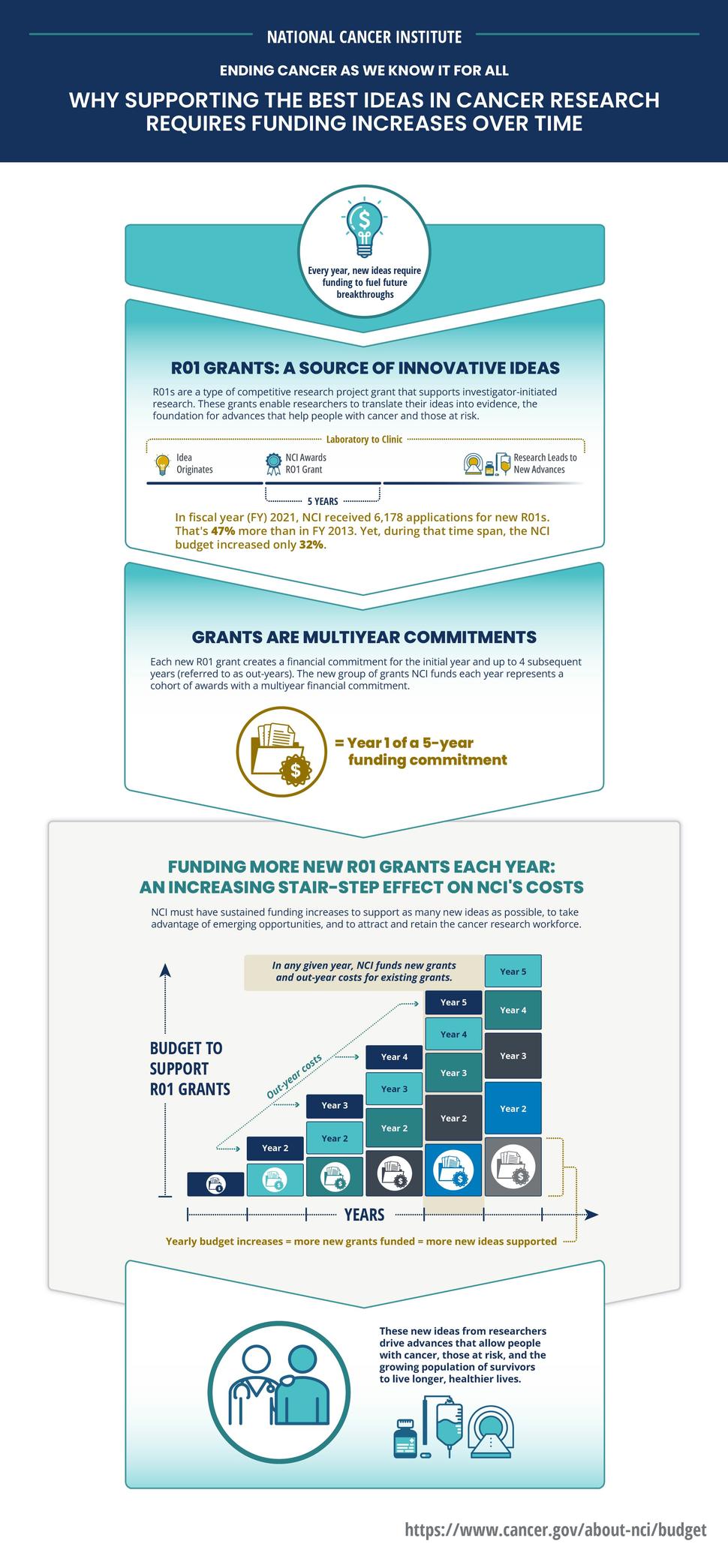What is NCI’s current fiscal year 2026 (FY26) budget?
NCI is operating under a continuing resolution (CR) that provides funding through January 30, 2026, at the same level as fiscal years 2024 and 2025.
The Full-Year Continuing Appropriations and Extensions Act, 2025 (H.R.1968) allocated funding to the NCI in fiscal year 2025 at levels consistent with fiscal year 2024 for a total of $7.22 billion.
Where does NCI’s funding come from?
As a federal agency, NCI receives its budget from the United States Congress. The President submits a budget request and spending priorities to Congress, but only Congress can actually provide funding—whether mandatory (direct spending typically dictated by statute, not appropriations bills) or discretionary funding, which is provided via the annual appropriations process. Appropriations are decisions made by Congress about how to designate discretionary federal spending. Congress provides the amount of funds that may be spent, along with guidance regarding funds available for certain initiatives (e.g., Childhood Cancer Data Initiative), and the period of time when NCI can use funds. The federal government's fiscal year (FY) runs from October 1 to September 30.
Since 2017, NCI has also received mandatory funding for the Cancer Moonshot through the 21st Century Cures Act. Congress authorized $1.8 billion in funding for the Cancer Moonshot spread over seven fiscal years, and Congress appropriated these funds from FY17 through FY23.
What steps are involved in the budget process?
The graphic below outlines each of the major steps in NCI’s funding process.
The federal budget process involves the preparation of separate reports and requests that relate to each other in varying degrees.
Each year NCI prepares and submits the NCI Annual Plan and Professional Judgment Budget directly to the President and Congress for review. The Annual Plan and Professional Judgment Budget is unique to NCI, and this process is required by the National Cancer Act of 1971. The Annual Plan and Professional Judgment Budget identifies NCI’s research priorities and provides a high-level overview of optimum funding needed to advance cancer research. It’s typically published over a year in advance of the fiscal year it outlines.
The White House’s Office of Management and Budget prepares the President’s Budget Proposal in coordination with all federal agencies. This annual document requests funding levels for the federal government for the upcoming fiscal year according to the President’s priorities. The President submits the budget request for Congress to consider when passing appropriations legislation to fund federal agencies.
NCI also prepares the Congressional Justification, in coordination with NIH, the Department of Health and Human Services, and the Office of Management and Budget. The Congressional Justification provides a detailed budget request that is incorporated into the President’s Budget Proposal. It outlines NCI’s mission, goals, and objectives for the coming fiscal year and provides comparative data and analysis for the previous, current, and proposed budgets.
If an appropriations bill is not passed by the start of the fiscal year (October 1), Congress may enact a continuing resolution, which provides federal agencies with limited, short-term funding, typically at the pre-existing appropriations level. Congress may pass multiple continuing resolutions until an agreement is reached on a final budget for the full fiscal year. If a budget agreement is not reached and no continuing resolution is passed, the government faces a shutdown.
How does NCI spend its budget?
As the leader of the cancer research enterprise, collectively known as the National Cancer Program, and the largest funder of cancer research in the world, NCI manages a broad range of research, training, and information dissemination activities that reach across the entire country. NCI leadership relies on advisory committees, external scientific experts, and NCI’s subject matter experts to provide objective advice regarding scientific priorities, development of extramural program initiatives, future direction of NCI’s intramural and clinical trials programs, and the Frederick National Laboratory for Cancer Research.
There are many ways to break down NCI’s spending; the graph below shows one example. Explore the interactive NCI Budget Fact Book for additional breakdowns and details on how NCI spends its budget.
- Research project grants make up the largest portion of NCI’s budget. These are awards made to institutions or organizations to support discrete, specified projects to be performed by named investigators in areas representing their specific interest and competencies (e.g., R01, R37). In the grant-making process, NCI relies heavily on rigorous scientific peer review. Learn more about NCI’s grants policies and process.
- Centers and SPOREs include grants for NCI-Designated Cancer Centers (e.g., P20/P30 grants), as well as Specialized Programs of Research Excellence (SPOREs) that focus on a specific organ site, on a group of related cancers, or other factors.
- National Research Service Awards (NRSA) is a trainee award program that helps ensure that a diverse pool of highly trained scientists is available in appropriate scientific disciplines (e.g., T32, F30).
- Research and development (R&D) contracts include the Frederick National Laboratory for Cancer Research, the Surveillance, Epidemiology, and End Results Program (SEER), and others.
- Other research includes the following grants: career programs (K Awards), cancer education, Predoctoral to Postdoctoral Fellow Transition Awards, education projects - cooperative agreements, minority biomedical research support, as well as NCI’s grant support for extramural clinical trials networks such as the National Clinical Trials Network, the NCI Community Oncology Research Program, and NCI-supported early-phase clinical trials networks.
- Intramural research funding makes up about 18% of the NCI budget. NCI’s more than 300 intramural researchers conduct basic, pre-clinical, clinical, genomic, and population-based research.
Major areas of NCI’s work that span more than one of the categories listed above include other support for clinical trials, training and career development, and basic science. These efforts are funded through multiple mechanisms and approaches, including intramural research, extramural research, national networks, and research project grants.
How does NCI make spending decisions?
When making spending decisions, NCI leaders must balance competing priorities, commitments, and opportunities to ensure continued progress toward its mission. NCI’s external advisory committees provide objective and expert advice on coordination of the institute’s activities. The institute does not use predetermined targets for specific disease areas or research categories to make spending decisions.
In the grant-making process, NCI relies heavily on scientific peer review. The first level of review is carried out by a Scientific Review Group composed primarily of non-federal scientists who review research proposals and judge them on factors such as:
- importance of the research (significance, innovation)
- rigor and feasibility (approach)
- expertise and resources (investigator, environment)
The National Cancer Advisory Board provides the second level of review. This intensive approach, in line with NIH's peer review process, ensures that NCI supports the best science aligned with its mission.
Research proposals are also further evaluated by NCI’s scientific leaders and program staff, who consider public health significance, scientific novelty, overall representation of the research topic within the NCI portfolio, diversity of thought, and other factors.
How are paylines related to NCI’s budget?
At the start of each fiscal year (or when NCI receives its appropriation for the fiscal year), NCI establishes a payline for that fiscal year. A payline is a percentile that represents a conservative funding cutoff point—a floor, not a limit—for new grant awards. At NCI, paylines based on percentile score are only relevant to R01/R37 and R21 grant types. The payline for applications from early-stage investigators is higher than for established investigators. NCI awards funding to nearly all grant applications with peer review percentile scores (based on impact scores) better than or equal to the payline. An impact score is assigned by reviewers of a grant application and indicates the scientific and technical merit of the application. Learn more about NCI’s grant policies.
Paylines are sometimes confused with success rates. A success rate refers to the proportion or percentage of grant applications that NCI was able to fund in a given fiscal year (the number of awards divided by the number of scored applications, expressed as a percentage), calculated retrospectively. Success rates are often used as an estimate of the likelihood of a particular grant application being funded. In contrast, a payline is a conservative floor set at the beginning of the fiscal year, based on resources available.
In order to increase paylines over time—to support more new research ideas—sustained budget increases are needed. As this infographic explains, when NCI funds a cohort of new R01 grant applications in a given year, this is a multiyear financial commitment of up to five years (which is the length of most R01 grants), but only the first year is usually funded at the time of the award. The overall cost of the new awards is usually greater than the cost of the recently completed awards, which means that sustained annual increases to NCI’s budget are required to raise the payline each year and to meet NCI’s commitments to continuing research and vital research infrastructure.
Learn more about NCI’s current paylines in this Bottom Line blog post: NCI's Fiscal Year 2025 Interim Paylines Announced.
Learn more about how NCI balances support for new and ongoing research: The NCI Research Projects Grants (RPG) Budget and Beyond (video).
What is NCI’s budget history?
Inflation’s effect on NCI’s budget
Sustained increases to NCI’s budget are also needed due to inflation. NCI’s budget (the dollar amount) and the value of NCI’s budget (how much research it can afford to support) have changed over time. A $1 million investment in research today is not worth the same $1 million investment as in the past. In other words, research has become more expensive over time. NIH uses a price index called the Biomedical Research and Development Price Index to quantify how much a budget must change to maintain purchasing power.
NCI’s overall budget appropriations are presented below for the last 20 years. The enacted appropriation levels do not include potential adjustments such as rescissions, sequestrations, supplemental funding, or Secretary's transfers that may have impacted the amount available for NCI expenditure.
Fiscal years 2017 through 2023 include funding appropriated through the 21st Century Cures Act, which authorized $1.8 billion in funding for the Cancer Moonshot over seven years. NCI’s base appropriations include funding for the Childhood Cancer Data Initiative (CCDI), $50 million per year, proposed for 10 years starting in 2020, and $28 million for the Childhood Cancer Survivorship, Treatment, Access, and Research (STAR) Act of 2018.




